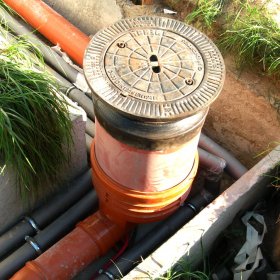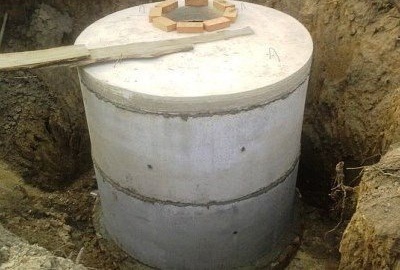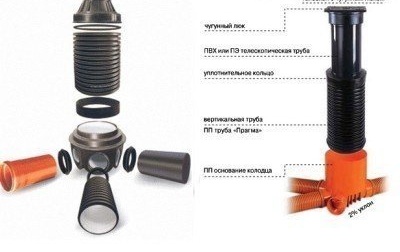Modern sewer well: device options and installation nuances

Each resident of a city apartment dreams of having his own individual courtyard. And if you can’t move to a private house, then having a summer cottage in an ecologically clean area is a completely feasible task. Whatever options you have to “try on” for yourself, in any case, you will have to deal with the arrangement of both the house itself and the adjoining territory. One of the first systems that will need to be built in a private house is sewage. Modern technologies offer many variations for its creation, but in any case it will be necessary to carry out the construction of a sewer well. This classic element is an integral part of any sewer system, so it deserves the most careful consideration.
Which sewer well to choose?
This information is of interest to everyone who has to solve the problem of a sewer device. To clearly understand how the system will work, you need to understand how its key elements function.
So, when choosing, you will have to consider sewer wells of these types:
- Lookouts - used to clean and control the sewer system.
- Overflow - Designed to level the differences in the pipeline, exceeding the permissible level.
- Swivel - are mounted on turns of sewer pipelines. Protect the system from blockages. At the same time are viewing.
- Cumulative - are intended for accumulation of drains. During operation, they require periodic cleaning, that is, pumping water with a pump or with the help of a sewage machine.
- Filtration - serve for pre-treatment of sewage. Fundamental waterproofing of sewage wells of this type is optional.
We choose the most practical and reliable material.
In principle, there is no special freedom of choice in this case. Today, in practice, two types of structures are mainly implemented: plastic and concrete.
Wells made of plastic
In the last decade, the installation of sewer wells involves the use of plastic structures. There are two key reasons: ease of installation and durability. Among other distinctive features it is worth highlighting:
- high strength - ability to withstand critical loads;
- wear resistance of the tray part;
- smoothness of internal and external surfaces;
- high tightness inset inlet and outlet nozzles.
Important! If necessary, you can contact the manufacturer and order the product for individual overall dimensions.
Reinforced concrete wells
Today, the question of how to make a sewer well from concrete is not relevant.Everything is extremely simple: the design is created from reinforced concrete rings of the right size.
Such a well has the following advantages:
- relevant for any soil;
- mounted quickly;
- reliability and high strength;
- inertness to any influences.
Wells from other materials
Craftsmen, despite the development of technology, manage to arrange sewer wells from improvised means. For example, lumber processed with special flame retardants and antiseptics or old wheel tires are used for this purpose. But now these are rather isolated cases, because such structures will not serve for a long time, and they do not differ in sufficient tightness.
How to determine the right size?
The answer to this question must be found one of the first. The diameter of the sewer well is a determining parameter when creating the entire sewer system as a whole. This implies both technical aspects and the cost of the sewer system. If we are talking about home use, then, as a rule, the height of the well is 2.5 m, but the diameter is the calculated value. And it is calculated using a formula that determines the volume of a sewer well: V = L * 3.14 * R2 (V is the water flow per month, L is the height). That is, the radius of the sewer well will be equal to R = the root of V / 3,14 / L, and the diameter, respectively, is a large 2-fold value.
Attention! The volume value used in the calculations should differ from the real one in the direction of increase. That is, it is necessary to consider a certain margin.
Calculation Example
V = 8 L
L = 2.5m
R = root of 8 / 3.14 / 2.5 = 1 m
Diameter (D) will accordingly be 2 m.
Features of the installation of polymer containers
Whatever the scheme of the sewer well, as an integral unit of the sewer system, in most cases today the use of ready-made plastic containers is implied. And although at first glance this seems to be a more expensive option, in reality there is the possibility of saving money on installation work.
The device of a plastic sewer well can be done even by a person who is far from locksmithing.
In short, the whole work consists of four stages:
- A pit of the right size breaks out.
- A sand-gravel-cement base (foundation) is created at the bottom.
- A plastic container is installed.
- Pipeline elements are being connected.
According to this principle, all the facilities provided for by the project are arranged, but it should be borne in mind that the distance between the observation type sewer wells should not exceed 15 m. At least 12 m should be retreated from the building. In general, all these values are strictly regulated by sanitary norms and requirements. They must be taken into account when creating a sewage project. Although such factors as the length of the highway, the presence of junctions or turns have a great influence here. For example, a diversion sewer well can be located at a specific nodal point, but the minimum distances must still be maintained.
Introductory video
Can you solve the problem of constructing a sewer well yourself - only you yourself will objectively answer this question. We offer to track how specialists perform this work, perhaps this will help you make the only right decision.






2 comments